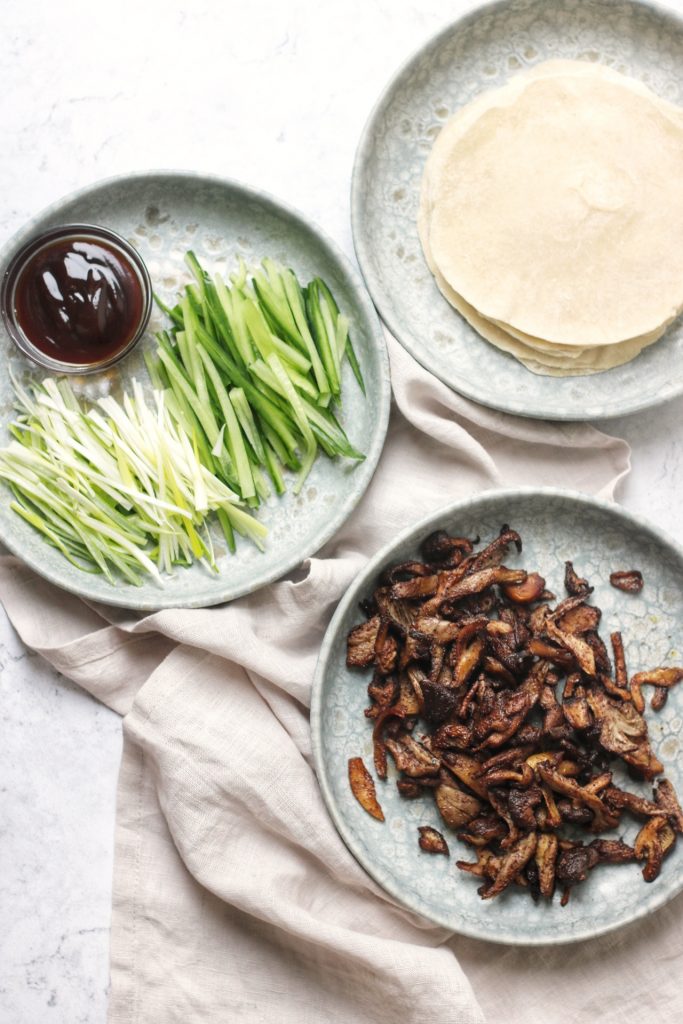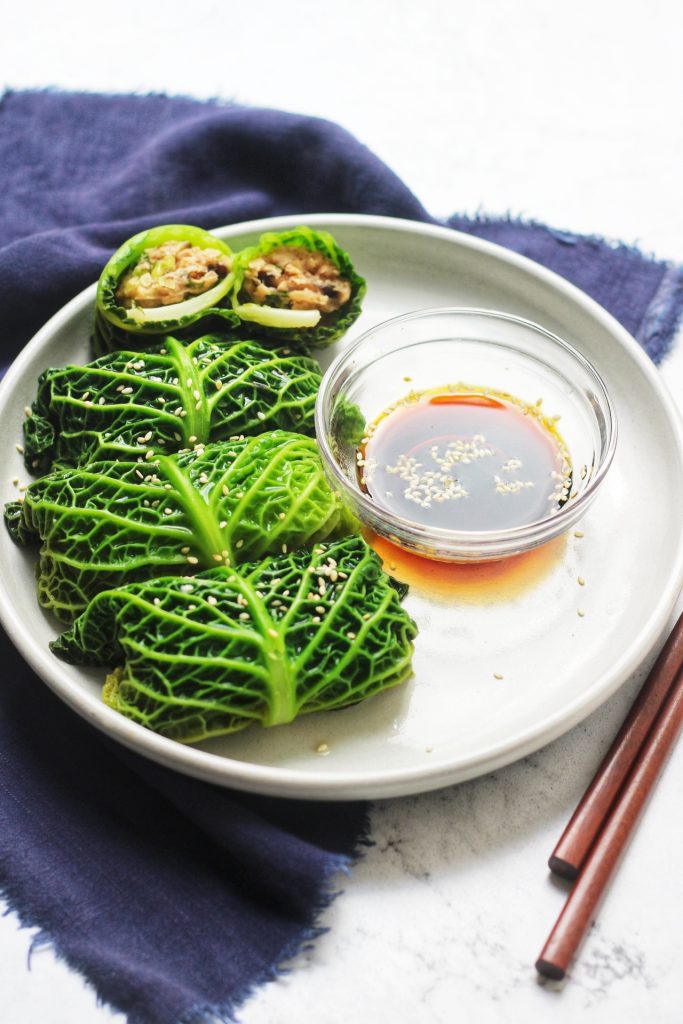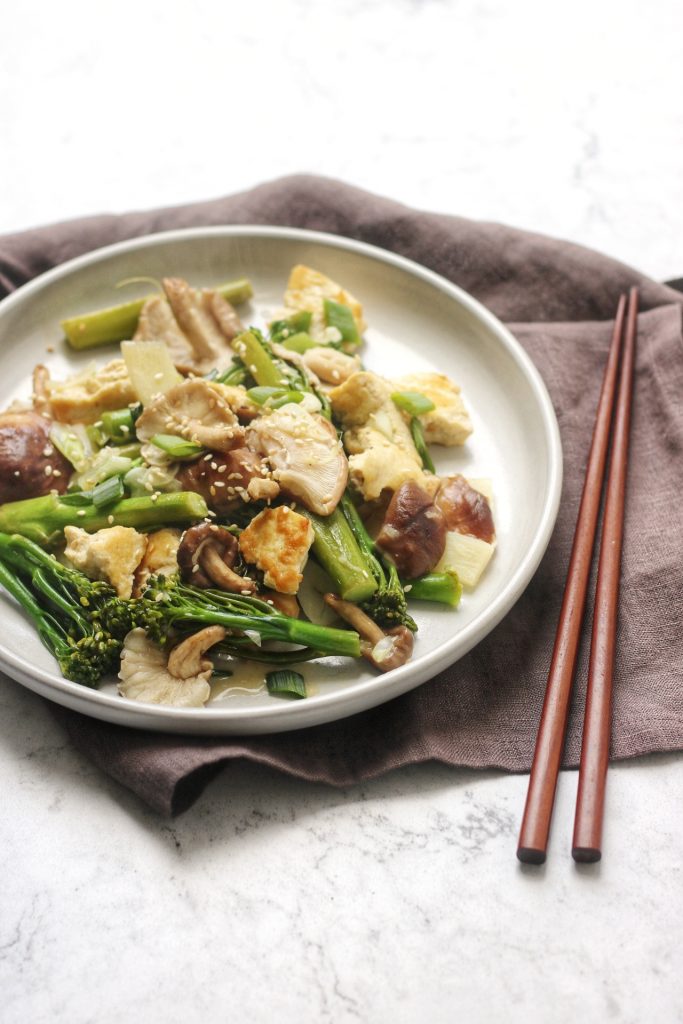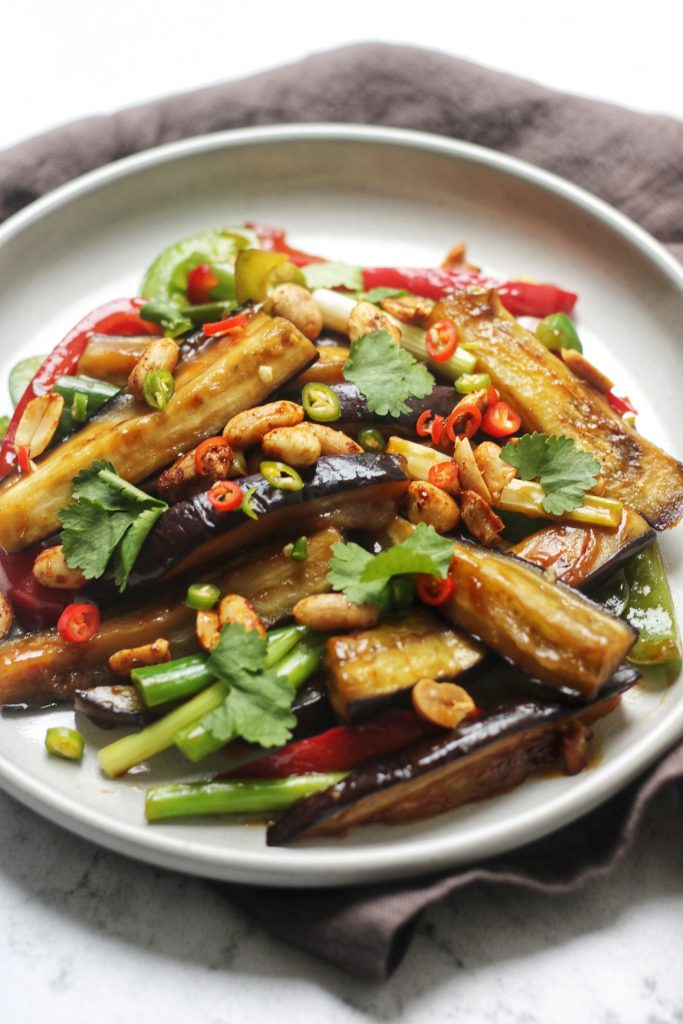Vegan Mapo Tofu with shitake mushroom
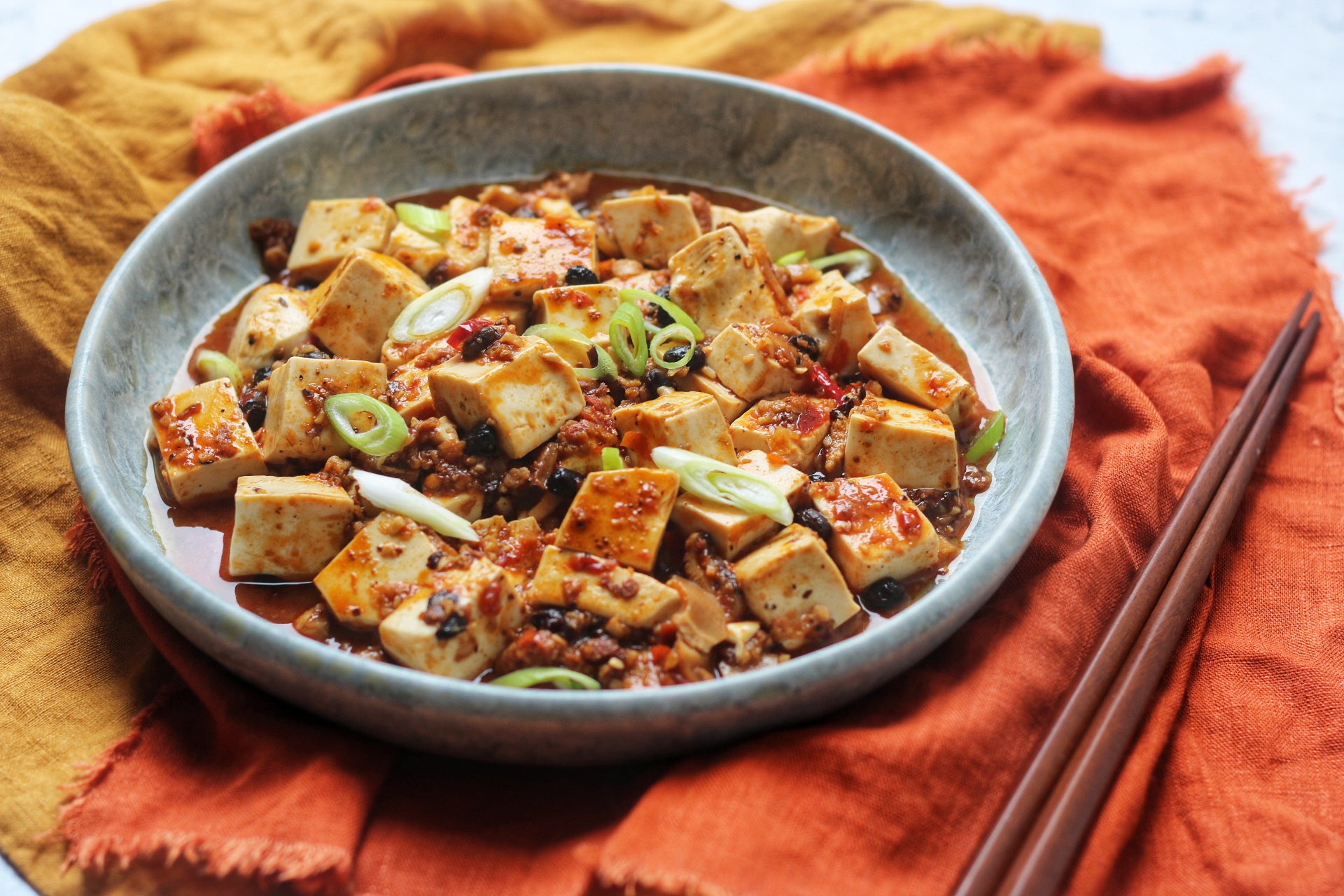
Vegan Mapo Tofu (or “pockmarked grandma’s beancurd”) is a rich and spicy Chinese dish that I’ve made suitable for anyone following a plant based diet. Get the recipe below.
Page Contents
What is Mapo tofu?
Mapo tofu is an incredibly popular dish that appears on Chinese restaurant menus everywhere. It is a delicious, spicy dish that cooks quickly and is made of braised silken tofu with minced pork (for those who eat meat) in a sauce made from fermented black beans and Sichuan pepper amongst other ingredients.
Today I am sharing with you my recipe for making this classic Chinese dish suitable for anyone following a plant based diet!
Key ingredients for making vegan Mapo Tofu
There are some essential ingredients that you have to have when making Mapo Tofu. Anything else and it just won’t be the same. They are:
- Ginger, garlic and spring onion (sometimes referred to as the cornerstone of all Chinese cooking).
- Sichuan peppercorns, chilli oil and fresh chillies (which can be adjusted depending on your spice tolerance).
- Fermented black beans and spicy bean sauce (which can be adjusted depending on your salt and spice tolerance).
- Tofu
- Pork mince substitute
I’ll take each of these in turn to explain what they are, where you can buy them, and why they are an essential ingredient for Vegan Mapo Tofu.
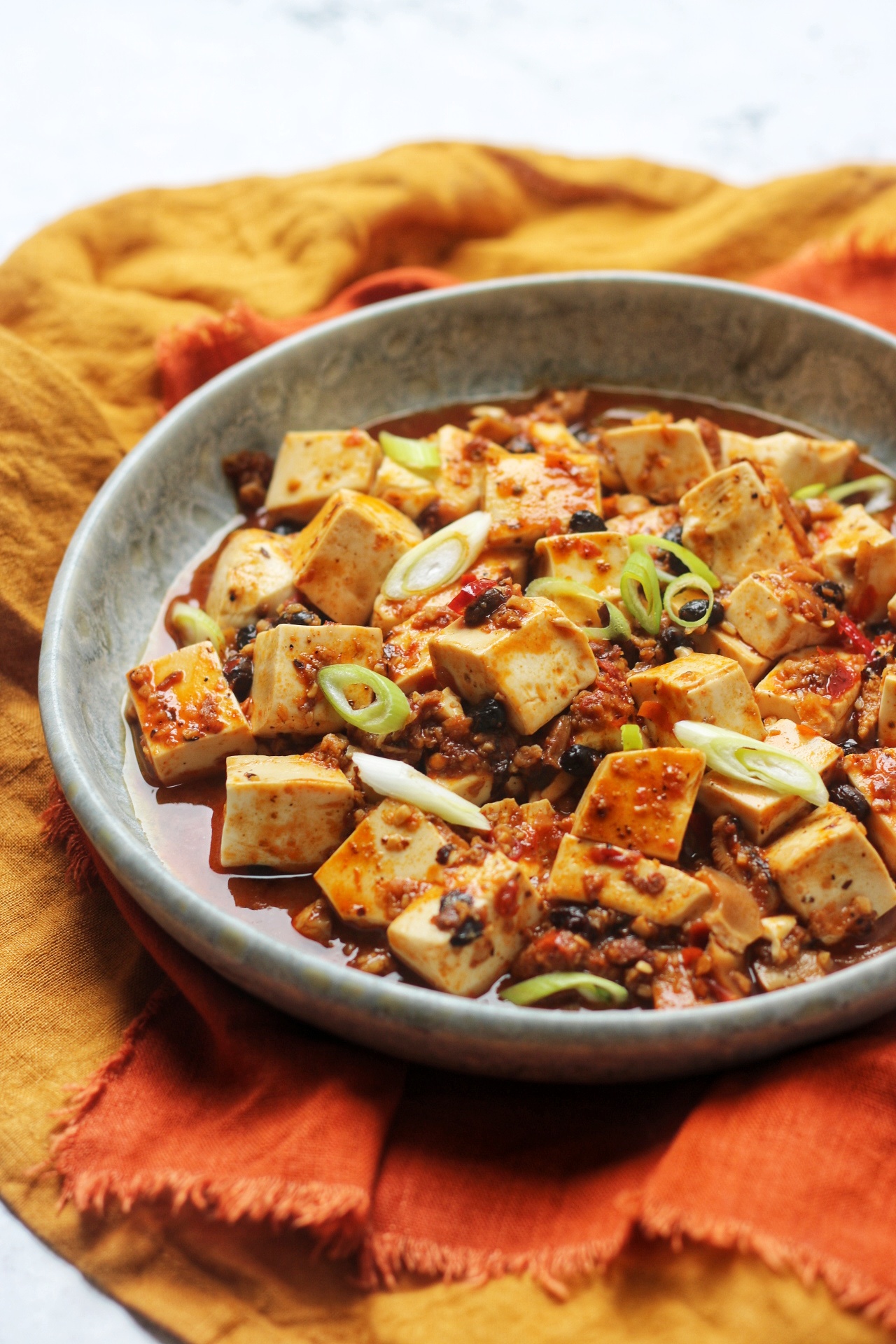
What spices are used in Mapo tofu?
Mapo Tofu is a hot dish, and by that I mean it is spicy! The heat comes from a couple of different places: whole, dried red chilli, Sichuan (Szechuan) peppercorns and spicy bean sauce (more more on the spicy bean sauce below).
Sichuan pepper is a spice commonly used in Sichuan cuisine. Sichuan is a province in the south-west of China and where Mapo tofu originates. Unlike chilli peppers, Sichuan peppercorns make your mouth tinge, then go numb when eaten. This is because they contain something called hydroxy-alpha sanshool.
You can find both green and red Sichuan peppercorns available to buy but red is the most common.
When Sichuan pepper and red chilli peppers are combined this is flavour is called mala or “numbing-spicy.” This is exactly what we want in our vegan Mapo tofu! But don’t be fooled, there’s more to Sichuan peppers than just being mouth-numbingly hot! They also have a wonderful lemon scented, floral flavour too.
What are fermented black beans and where can I buy spicy bean sauce?
Fermented black beans are a commonly used ingredients in Chinese cuisine. They are also called salted black beans, fermented black soybeans, preserved black beans, or even just black beans in Oriental supermarkets.
They are made from black soybeans that have been fermented with salt and so, unsurprisingly are quite salty in taste. Fermented black beans are often soft, partially dried and need rinsing slightly before using in dishes such as this.
You cannot use canned regular black beans or dried black beans as a substitute! They are a unique ingredient that is essential for this dish.
As well as the fermented black beans, Mapo tofu also includes fermented soybeans, broad beans, and chilies which have been turned into a spicy paste known as la doubanjiang.
Doubanjiang is often used in Sichuan dishes so it’s no surprise that it’s the basis of the sauce for Mapo tofu.
It’s a slightly chunky (not smooth) reddish-brown paste. It has a distinctly savoury flavour that is also a little spicy, and salty. It brings amazing depth of flavour to this dish as well as chilled, spicy silken tofu.
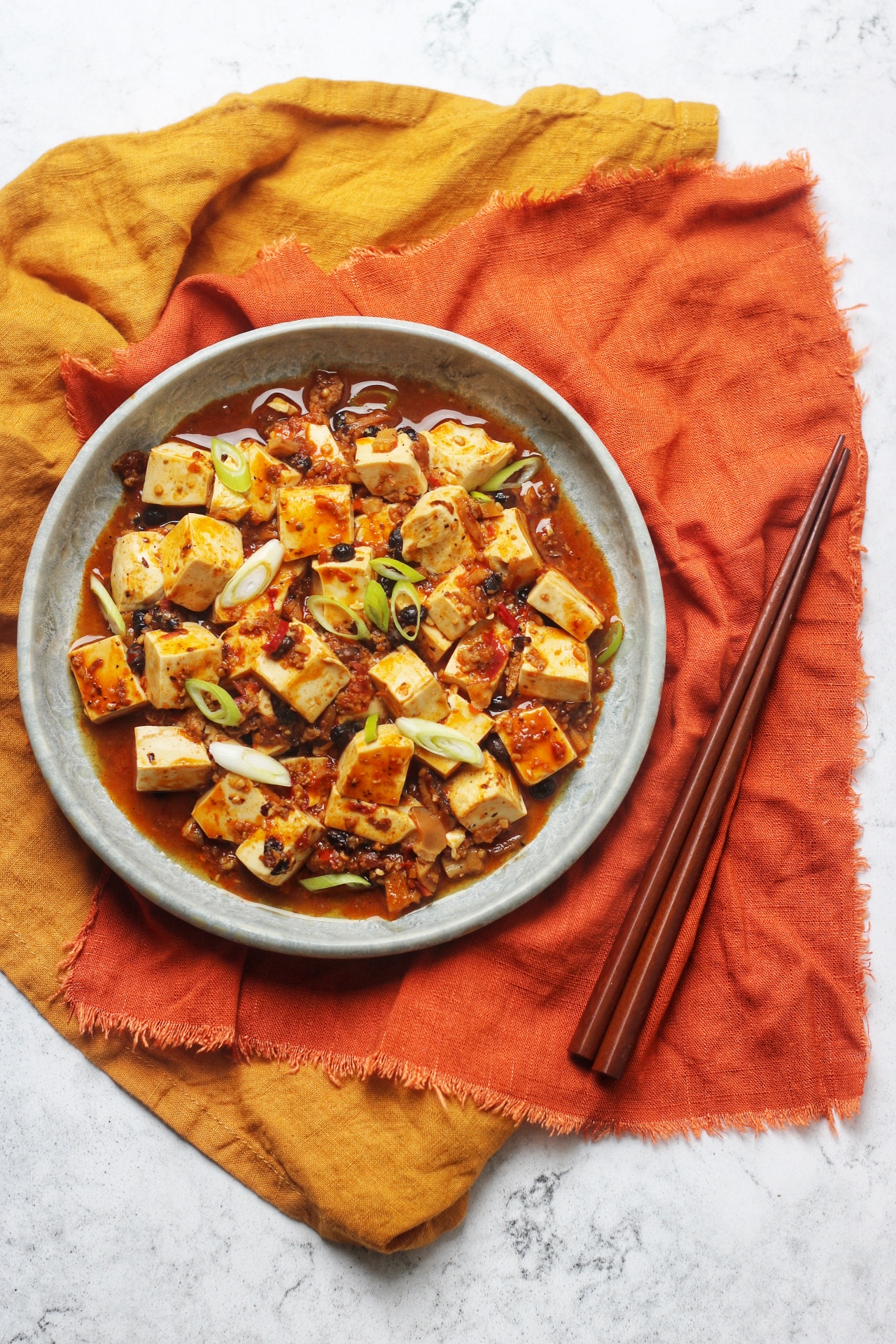
What type of tofu is used in Mapo tofu?
Traditionally, Mapo Tofu is made with soft or silken tofu. The wobbly, smooth, creamy cubes of tofu are the perfect contrast to the spicy sauce they are cooked in. But, this perfect texture and flavour combination comes at a cost.
Silken tofu is very delicate, and can easily break up and turn to small flakes if you don’t look after it in the pan. Cutting the tofu and stirring the dish needs to be done very carefully. A slow folding motion works best. To make the tofu a little easier to work with it is recommended that you heat it thoroughly in hot (but not boiling) water for 5 to 8 minutes and then add it to the sauce. This step is included in the full recipe below.
It might be tempting to avoid this issue by using firm tofu instead. Whilst the dish will still be delicious it won’t be quite the same as the original recipe. As a compromise, I can recommend the soft (but not silken) tofu made by theartyvegan. It’s easier to handle in your wok but not too firm either.
Pork mince substitutes for vegan Mapo tofu
Other than the pork or beef mince that is usually found in traditional Mapo Tofu recipes, this dish is vegan! So, by simply omitting the meat you can have a plant based meal in no time at all. But, by leaving it out altogether I think you miss two things. First, the rich, salty, fatty flavour that comes from the pork mince. And second, the crumbly texture of the mince alongside the soft silky tofu. I love this textural contrast and so I don’t like to skip the meat altogether. I prefer to use a vegan pork substitute.
The most commonly made substitute in vegan Mapo tofu recipes is to finely dice shitake mushrooms. And, I agree this works really well. Particularly if you like to avoid processed meat substitutes. If you can’t get hold of shitake mushrooms, chestnut mushrooms will also work.
But, my current favourite substitute is OmniPork mince. I’ve talked about OmniPork mince before in this recipe for Vegan “Pork” Stuffed Cabbage Rolls. It’s an incredibly realistic pork mince substitute that was created with Asian cooking in mind. In the UK, OmniPork is available from a limited number of online vegan supermarkets. I buy mine from The Vegan Kind Supermarket.
If you can’t get hold of OmniPork mince I can also recommend
For this recipe I’ve used a combination of shitake mushroom and vegan mince. That way I get the best flavour and texture possible!
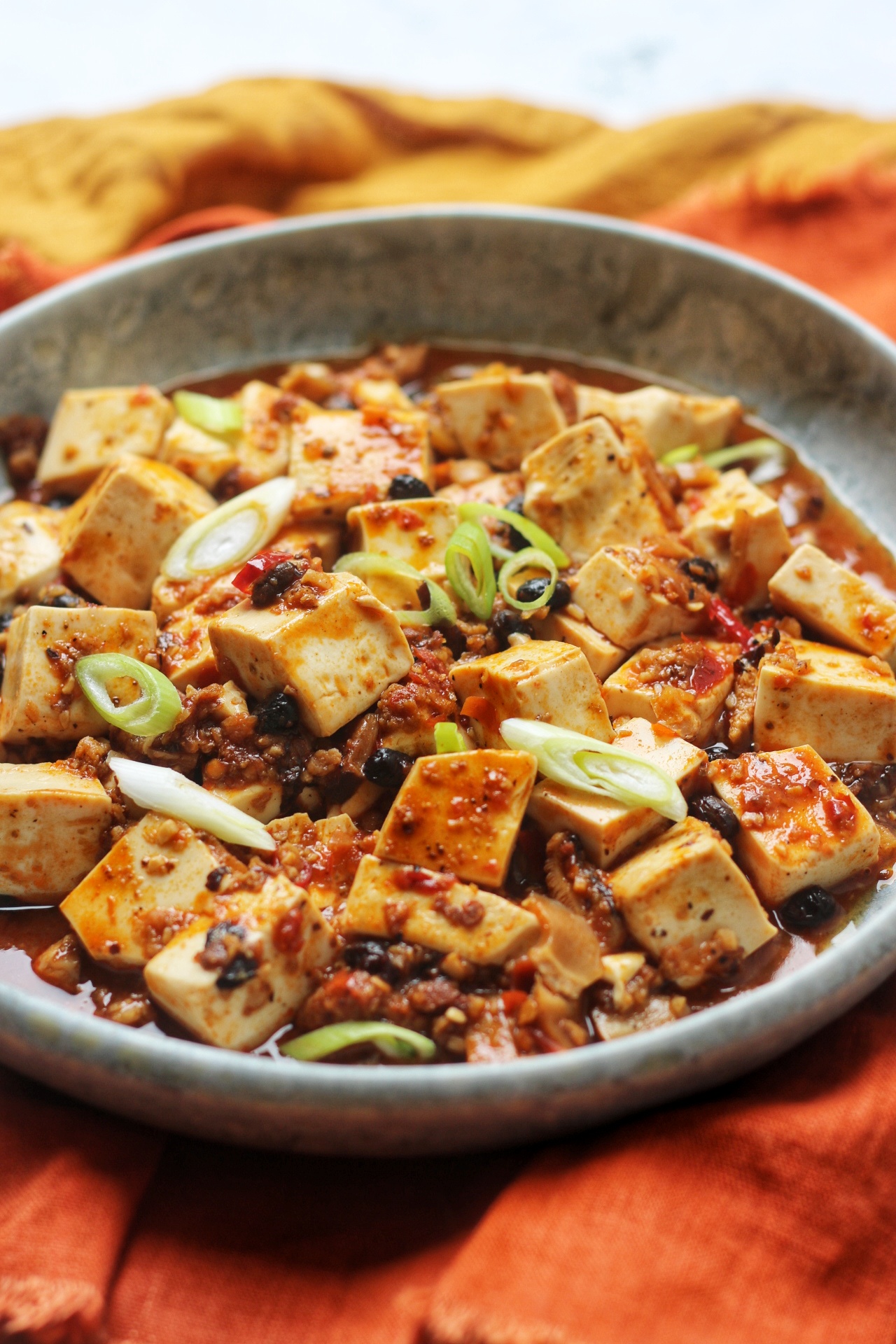
The recipe
Now I’ve explained the ingredients you need, let’s get cooking!
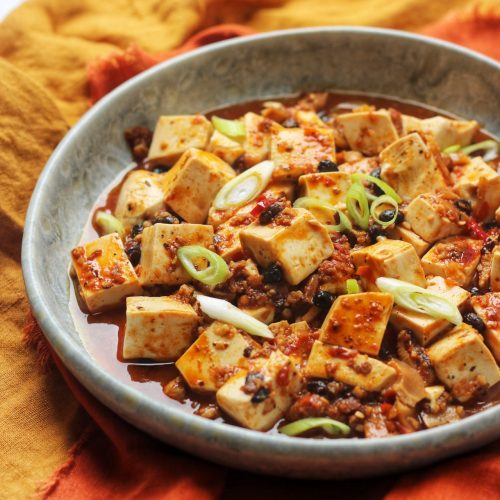
Vegan Mapo Tofu with shitake mushrooms
Ingredients
- 50 grams shiitake mushrooms dried
- 150 grams vegan mince
- 250 ml water
- 400 grams silken tofu
- 2 tablespoons vegetable oil
- 2 small dried red chillies sliced
- 1.5 tablespoon fermented black beans rinsed
- 2 tablespoon spicy bean paste
- 2 teaspoons garlic minced
- 1 inch root ginger grated
- 1 tablespoon soy sauce
- 1 teaspoon sesame oil
- 1 teaspoon Sichuan peppercorns ground
- 1 tablespoon cornflour
- 2 spring onions sliced
Instructions
- Re-hydrate the shitake mushrooms in 250 millilitres of boiling water. Once re-hydrated (roughly 20 minutes) drain the mushrooms, keeping the broth for later, and finely chop them.
- Next, cut tofu into 1 inch cubes.
- Bring a pan of boiling, salted water, to the boil. Add the cubes of tofu and let them sit for 15 minutes to firm up.
- In the meantime, heat the vegetable oil in a wok or wide-bottomed pan over a medium heat.
- Add the chillies, black beans and spicy bean paste and cook for 1-2 minutes until sizzling.
- Add garlic and ginger for 2 minutes before adding the vegan mince, chopped mushrooms, soy sauce, sesame oil and Sichuan pepper. Cook until the mince is hot and cooked through.
- Add the reserved mushroom broth and bring to a simmer.
- Once the sauce is bubbling, strain the tofu and add to the pan.
- Swirl the sauce so that it gently coats the tofu.
- Dissolve the cornstarch with 3 tablespoons of the sauce then add this cornstarch slurry back to the pan.
- Again, swirl the sauce so that the cornstarch is evenly distributed.
- Cook for 5 – 10 minutes or until the sauce has thickened slightly and the tofu is well coated.
- Serve with the spring onion slices sprinkled over the top.
Notes
Are there any alternatives to spicy bean paste?
You could easily make your own with the ingredients I’ve mentioned above. At a push you could use gochujang, a red chilli paste that is a core component of Korean cooking. Gochujang is also made with fermented soy beans and chilli but one of the key differences is that gochujang is made from rice instead of broad beans. I find that gochujang is sweeter than doubanjiang so you may need to adjust the seasoning if you use it as a substitute in this dish.Nutrition
More Chinese inspired recipes
After my first trip to China in 2017, I have been trying to create vegetarian and vegan versions of my favourite Chinese recipes. Why not give some of these dishes a go.
Travelling around China
If you want to find out more about my time spent visiting China including the food and drink we enjoyed, check out these posts:
- How to find vegetarian food in China
- A guide to craft beer in China
- 10 things you need to know about visiting China in Chinese New Year
- Touring China with Trailfinders Private Tours
You can find the full travel archive here.
